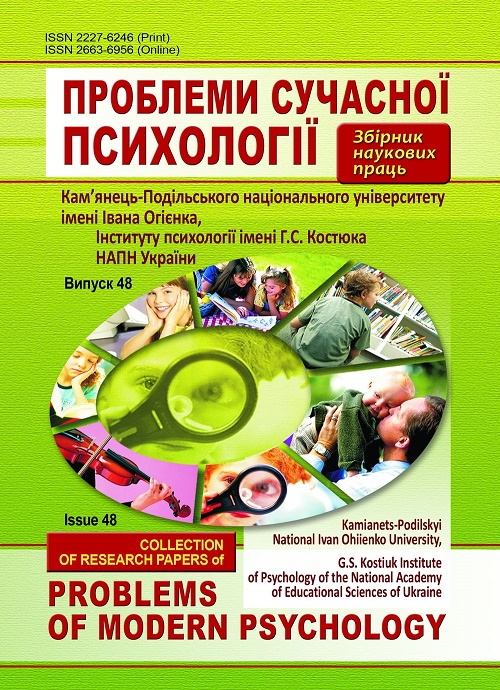Psychological Features of Empathy Formation in Adolescents with Mental Development Disorders
DOI:
https://doi.org/10.32626/2227-6246.2020-48.59-87Keywords:
adolescence, disorders in mental development, emotional-volitional sphere, empathy, compassion, emotional response.Abstract
The aim of the article is to identify and experimentally test the state of
the empathy formation and its impact on the formation of emotional and
volitional sphere of adolescents with disorders in mental development. The
purpose of the research was to provide step-by-step solution of the main tasks:
firstly, to state the condition of the development of empathy by identifying its
components, indicators and levels of their formation; secondly, identifying the
main factors for developing empathy of adolescents with mental development
disorders; establishing basic peculiarities affecting empathy as a component
of the emotional-volitional sphere of adolescents’ personality with mental
development disorders.
Мethods. Scientific and specific research methods were used to solve
the tasks and to ensure the validity of the research and conclusions. Among
them there are theoretical and empirical methods, which allowed to establish
quantitative and qualitative characteristics of the phenomenon, to characterize
indicators and to set levels of this phenomenon. Psychodiagnostics was conducted
in accordance with the requirements and instructions of the methodology
having been used, conversations were also organized among the adolescents,
and behavioral monitoring was conducted under the usual conditions during
their educational activities. For the purpose of comparing and analyzing the
phenomenon of empathy, diagnostics of adolescents with preserved intelligence
of the relevant age categories was also performed under the same conditions as
adolescents with disorders in mental development.
The results of the research. According to the results of the diagnosis of
empathy as the indicator of the development of the emotional-volitional sphere
of a personality and the structure of a personality, adolescents with disorders
in mental development were found to have insufficient orientation of mental
processes, communicative properties, empathy, identification with others and
distance from them. It was found that the level of empathy was characterized
in adolescents with disorders in mental development like low and average level
among adolescents with preserved intelligence. Channels of empathy and the
levels of their formation among adolescents were also described in details.
Conclusions. The results made it possible to ascertain among teenagers
with disorders in mental development low differentiation of «Me»-image; low
adaptability to external stimuli (low level of adequacy of expression of emotions
according to the situation); the formation of a leading emotional modality –
anger; insufficient mediation of interpersonal contacts, communicative ability;
unconscious empathy, identification with other people and taking distance from
them.
References
Бех І. Виховання особистості. Київ : Либідь, 2003. 280 с.
Бойко В. Оценка эмпатии личности. Санкт-Петербург : Креп, 2002. 231 с.
Выготский Л. Педология подростка. Москва : Педагогика, 1981. 504 с.
Журавльова Л. Психологія емпатії. Житомир : Вид-во ЖДУ ім. І. Фран¬ка, 2007. 327с.
Лебединская К. Подростки с нарушениями в аффективной сфере: кли¬нико-психологическая характеристика «трудных» подростков. Москва : Педагогика, 1988. 168 с.
Ліхацька Т. Психологія розумово відсталого підлітка. Київ : Центр знань, 2001. 204 с.
Пагава Д. Емпатія підліткового віку за умов психофізіологічних пору-шень. Харків : Київські читання, 2017. 202 с.
Рябовол Т. Емпатії в процесах онтогенетичної адаптації особистості. Вінниця : КМП РТ, 2017. 182 с.
Савчин М. Вікова психологія. Київ : Зміст, 2005. 243 с.
Сухарева Г. Педагогика чувств. Киев : Знания, 1992. 147 с.
Хоменко М. Емоційно-вольова сфера дітей з розумовою відсталістю: гендерний аналіз. Київ : Солдт ЛТ, 2014. 176 с.
Эльконин Д. Возрастные и индивидуальные особенности младших по-дростков. Москва : Просвещение, 1967. 360 с.
Яковенко О. Психокорекційні методики формування та корекції емо¬ційно-вольової сфери підлітків з порушеннями психофізіологіч¬ного розвитку. Чернівці : Ліга, 2012. 112 с.
Freud, A. (1958). Adolescence: the psychoanalytic study of the child. New York. 109 p.
McDougall, W. (1921). Physiological psychology. London. 218 p.
Rogers, С. (1959). Entwicklung der Persönlichkeit. Stuttgart. 167 р.
Sullivan, H. (1970). Personal psychopathology. New York : B&D Books. 189 p.
Wanda, A. (2004). Emotional – cognitive structuring. Toronto. 148 p.
Downloads
Published
How to Cite
Issue
Section
License
Copyright
The Editorial Board has the full right to publish original scientific papers containing results of theoretical and experimental research works which are not currently subject to review for publication in other scientific editions. The Author shall transfer to the editorial board of the Collection the right to spread the electronic version of the paper, as well as the electronic version of the paper translated into English (for papers originally submitted in Ukrainian and Russian) by all kinds of electronic means (placement at the official website of the Collection, electronic databases, repositories etc).
The Author of an article reserves the right to use materials of the paper, without approval with the editorial board and the founders of this Collection: a) partially or fully, for educational purposes; b) for writing own dissertation papers; c) for preparation of abstracts, conference reports and presentations.
The Author of an article can place electronic copies of the paper (including the final electronic version downloaded from the official website of the Collection) at:
- personal web resources of all Authors (websites, webpages, blogs etc.);
- web resources of the institutions where the Authors are employed (including electronic institutional repositories);
- non-profit public access web resources (for example, arXiv.org).
But in all cases, it is obligatory to have a bibliographic reference to the paper, or a hyperlink to its electronic copy placed at the official website of this Collection.






